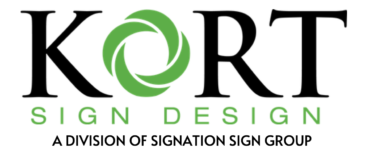Our client, Engineered Flexible Products, asked us to create a custom-made tabletop display with an industrial look and multi-purpose functionality. The display needed to be able to hold EFP’s products while also allowing the customer to be able to lift some of the products off the display. Spencer asked one of the EFP owners to come into the sign studio to discuss his vision for the display. He brought in the actual products so Spencer could examine the shape, size and weight of each one. They worked together to come up with a design by laying out the products on a piece of 36” x 30” craft paper, moving them around until they liked the composition, and then outlining them with a marker.
They also came up with a hook-like system that would hold
the products on the display but could also be lifted off easily without it
falling over. A cable tie system was created for some of the products that were
not removable. They marked where these would go as well on the craft paper.
To create the industrial look, Spencer took Dave back to the shop so he could
choose the best material to display his products. They decided on a brushed
aluminum ACM (Aluminum Composite Material) which is a double-sided aluminum
that sandwiches plastic. ACM would be strong enough to hold his heavy products
while also giving the products a rugged yet polished backer to be presented on.
Brushed Aluminum only comes in 3mm thick ACM, which isn’t sturdy enough to hold
the products, so we had to add a black 6mm PVC backer to give more support and
to hide all the screws, L hooks, and zip ties that would be on the back of
display.
Spencer took pictures of the rough draft on craft paper so he could take it to
the computer and make a mockup. Digitizing the display would make it easier to adjust
details and make changes quickly. He also had to set up a working file as a
template to cut out on the CNC router. Using Adobe Illustrator, he made mockups
of the design and an estimate of what it would cost to produce the display. The
client suggested a few changes to the mockups, and then once those were completed
and approved, the project was started.
A final step was to create a way for the display to stand on
a tabletop or be hung on a wall. Spencer came up with a wing-like system to
hold the display from the back. The wings would be “piano hinged” so they could
be folded under for easy transportation. The wings would also be cut with an
inch angle off the bottom so the display could be tilted back to support the
heavy products on the front. This wing-like system would help support the front
while a couple picture frame loops were attached to the back to support the display
on the wall.
Using the files that Spencer made in Adobe Illustrator, we plugged them into
our routing software so the CNC router would be able to execute the design.
Using the CNC is sometimes tricky because the software needs to know size of
material you’re using; what type of bit you’re using to cut the material;
whether it’s an upcut or down cutting bit, etc. We also want to be able to use
as much material as we can with little to no scrap. Laying out in the CNC
program will help with that.
After checking that everything is good on the design side,
we make sure the CNC is lined up and cutting where we want it to cut on the
material. Once the material is cut, we sand any imperfections that where left
from the CNC. Assembling the pieces in the studio, Spencer first attached the
3mm brushed aluminum to the 6mm PVC using construction adhesive. He put weights
on it and let it sit for a day to make sure that the ACM bonded to the PVC the
best it could.
The digital information for the display would be printed on our large format
printer. We chose to print it on a translucent clear vinyl so that the brushed
aluminum ACM would show through the print. When printing on vinyl we must make
sure that we have crop marks and bleeds so that the print would fit perfectly on
the material. When applying vinyl, it can also be tricky to make sure there is
no dust or debris that gets trapped under the vinyl when applying. In an ideal
world, the work would be 100% clean with no air bubbles and nothing trapped
underneath but that’s not always the case. We can clean things up with a few
“tricks of the trade” and make it look awesome. (Spencer is very picky and
always strives for perfection.) After applying the see-through vinyl to the
brushed aluminum, he drilled holes for the L hooks and for the zip ties to hold
the products. He then attached the piano hinges that hold the wings and screwed
in the L hooks. Now that’s a custom project!
The display is completed and represents the Engineered Flexible Products’ brand
with an industrial look and professional design. The client appreciated the
collaboration as well as the quick turnaround time. In fact, we’ve been asked
to create five more of these custom displays for EFP! Spencer and the entire
KORT crew love this type of creative project and would be happy to work with
you on your product display needs.
